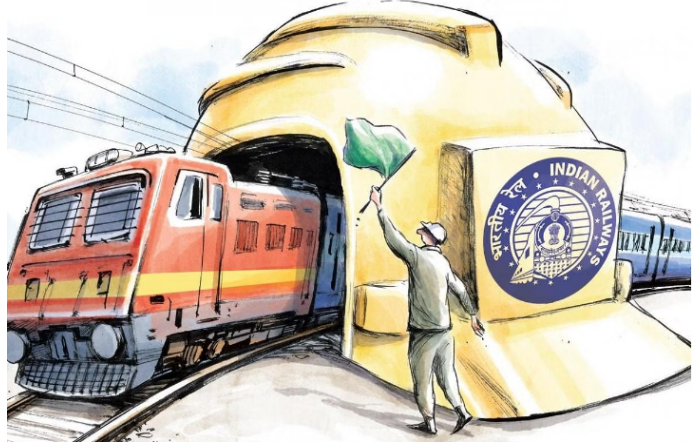- Courses
- GS Full Course 1 Year
- GS Full Course 2 Year
- GS Full Course 3 Year
- GS Full Course Till Selection
- Online Program
- GS Recorded Course
- NCERT (Recorded 500+ Hours)
- Polity Recorded Course
- Geography Recorded Course
- Economy Recorded Course
- AMAC Recorded Course
- Modern India, Post Independence & World History
- Environment Recoded Course
- Governance Recoded Course
- Science & Tech. Recoded Course
- International Relations and Internal Security Recorded Course
- Disaster Management Module Course
- Ethics Recoded Course
- Essay Recoded Course
- Current Affairs Recoded Course
- CSAT
- 5 LAYERED ARJUNA Mentorship
- Public Administration Optional
- ABOUT US
- OUR TOPPERS
- TEST SERIES
- FREE STUDY MATERIAL
- VIDEOS
- CONTACT US
Kavach System
Kavach System
09-11-2023

Why in News?
The recent train collision in Vizianagaram, Andhra Pradesh, highlighted the lack of the indigenous 'Kavach' Traffic Collision Avoidance Systems, which could have prevented the incident.
What is Kavach?
-
About:
- Kavach is a train control system designed by RDSO in collaboration with three Indian vendors, offering anti-collision features.
- The National Automatic Train Protection (ATP) System has been implemented.
- The system, following SIL-4 standards, serves as a vigilant watchdog over the signaling system, alerting the pilot to'red signals' and applying automatic brakes if necessary.
- The system also sends SoS messages during emergency situations.
- Network Monitor System provides centralized live monitoring of train movements.
- The Indian Railways Institute of Signal Engineering & Telecommunications (IRISET) in Secunderabad, Telangana, is the 'Centre of Excellence' for Kavach.
-
Components of Kavach:
- Kavach setup comprises three crucial components for designated railway stations along the intended deployment route.
- First Component: Initial step involves incorporating RFID technology into the tracks.
- RFID uses radio waves to identify objects or individuals, and electromagnetic fields to automatically read wireless device information from a distance without physical contact or line of sight.
- Second Component: The driver's cabin of the locomotive is equipped with RFID readers, a computer, and brake interface equipment, serving as the second component.
- Third Component: The system includes strategically installed radio infrastructure, including towers and modems, at railway stations to ensure the system's functionality.
-
Functioning:
- Kavach system employs the Traffic Collision Avoidance System (TCAS) to facilitate two-way communication between the station master and the loco-pilot.
- system uses equipment onboard locomotives and transmission towers, connected via RFID tags, and a cabin instrument panel for displaying signals and speed limits.
- Kavach system controls train movements by applying sudden brakes and activating a hooter near level crossings, especially in low visibility conditions like fog.

-
Challenges in Deployment:
- Current deployment cost of ₹50 lakh per kilometer is insufficient for comprehensive implementation across the 68,000 km rail network, covering only 1,500 km.
Significance
-
Safety:
- Kavach system aims to prevent rail track accidents, such as train collisions.
- The system will halt all trains within a 5-km range once activated to ensure the safety of trains on adjacent tracks.
- Currently, loco-pilots or assistant loco-pilots are required to monitor for caution signs and signals.
-
Cost:
- The operating cost of the system is only Rs 50 lakh per kilometre, which is significantly lower than the global cost of Rs 2 crore.
-
Communication:
- System will incorporate stationary equipment to collect signaling inputs and transmit them to a central system for seamless communication with train crews and stations.




